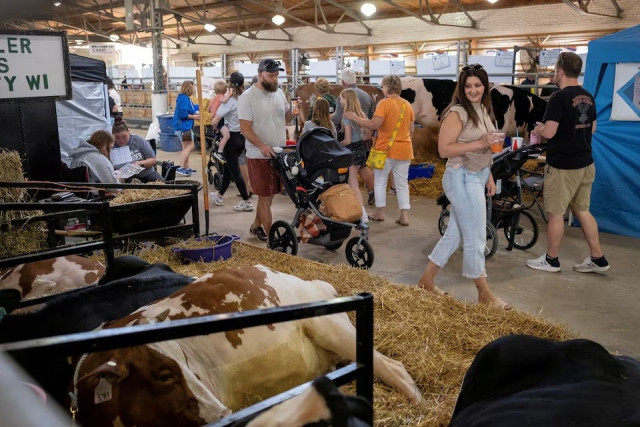State fairs in US get creative with fake cows
With real cows out due to bird flu, Michigan unveils milkshake and buttercup for milking demos

This year in Michigan, where both dairy workers and cattle have been affected by the bird flu outbreak, an unexpected pair of prized cows are preparing to take the stage at the state fair. However, these aren't your typical bovines. Milkshake and Buttercup, two life-sized fiberglass cows complete with rubber teats and water-filled udders, will be used in a popular milking demonstration. This creative solution comes as real dairy cows are unable to participate due to health concerns.
The Minnesota State Fair has taken a similar approach. For their hands-on milking event, they are using a fake dairy cow named Olympia. "Normally, we'd have a real cow out there," explained Jill Nathe, the deputy general manager of agriculture and competition at the fair. "But we just can't do that right now."
The spread of avian influenza has caused significant disruptions for state and county fair organizers, forcing them to rethink long-held summer traditions cherished by both city dwellers and rural communities. The virus has not only infected poultry but has also begun affecting cattle herds for the first time this year. In addition, four dairy workers have contracted the virus, making it a growing concern for public health.
For farmers and students who eagerly anticipate winning blue ribbons and earning bragging rights, the outbreak has introduced new challenges. They must navigate strict testing rules and handle logistical difficulties to ensure their animals are healthy before they can enter the show ring. Officials at both the state and local levels are working to protect people and animals from the H5N1 virus, as some dairy farmers have resisted testing their herds. Experts are concerned that continued transmission of the virus could increase the likelihood of it adapting to spread between humans.
The risk of viral spread among herds has led some county fairs in Michigan to cancel their dairy shows altogether, while the Iowa State Fair has shut down its milking barn. In Minnesota, state fair staff have stocked up on extra gloves and face shields from COVID-era supplies to protect the livestock crew. They also made the decision to keep pregnant dairy cows out of the fair's birthing center as an added precaution.
Several farm-heavy states, including Wisconsin, have implemented new testing requirements. Lactating cattle are required to test negative for H5N1 within seven days before arriving at the fairgrounds. Rick "RT" Thompson, a Wisconsin dairy farmer, described the extra planning necessary to comply with these rules. He had to coordinate his veterinarian's visits carefully to ensure that milk test results would be available within the required window for different fairs. Thompson’s vet's wife even drove samples to a state lab in Madison to make sure they arrived in time for testing. "It's not a convenient thing," admitted Thompson, who has been attending the Wisconsin State Fair for 46 years.
In Michigan, the situation is even more stringent. The state has banned lactating cows from public exhibitions until two months pass without any new cases in herds. Unfortunately for Michigan farmers, this means the opportunity to showcase cows at the state fair has already passed for 2024. The state reported its most recent case on Monday. "We were all waiting for that 60-day window," said LC Scramlin, the livestock director for the Michigan State Fair. "But we kept having another case and another one happen."
In Wisconsin, where the state fair offers everything from cream puffs to hot tubs, veterinarians performed inspections on cattle as soon as they arrived to ensure they were healthy. This was a significant departure from previous years, exhibitors noted. Jennifer and Bethany Droessler, sisters from Cuba City, Wisconsin, made the tough decision to keep their lactating cow at home. Instead, they brought other cattle to display at the event's Dairy Lane, where fairgoers took selfies with animals weighing over 1,000 pounds. "We'll aim for next year and hopefully it won't be an issue," said Jennifer Droessler, 30.
Since March, more than 190 dairy herds across the country have been infected with H5N1. Thirteen farm workers have tested positive after exposure to infected cows and poultry. Thankfully, all workers have recovered, and the US Centres for Disease Control and Prevention (CDC) maintains that the virus still poses a low risk to the general public. However, the CDC advises fairgoers to avoid eating, drinking, or touching anything in animal areas.
Despite these warnings, many visitors at the Wisconsin State Fair seemed unconcerned. The state, known for its dairy production, is second only to California in milk production and is the leading cheese maker in the US Fairgoers casually strolled through the event, enjoying treats like taffy apples and cheese curds.
"I don't think it's a big risk," said O.E. Glieber, an 88-year-old from Delafield, Wisconsin, who attended the fair with his grandchildren. "The CDC overreacts with a lot of stuff."



















COMMENTS
Comments are moderated and generally will be posted if they are on-topic and not abusive.
For more information, please see our Comments FAQ